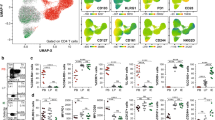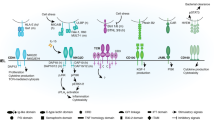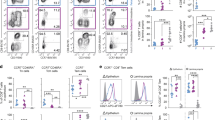Abstract
The presence of immune memory at pathogen-entry sites is a prerequisite for protection. Nevertheless, the mechanisms that warrant immunity at peripheral interfaces are not understood. Here we show that the nonclassical major histocompatibility complex (MHC) class I molecule thymus leukemia antigen (TL), induced on dendritic cells interacting with CD8αα on activated CD8αβ+ T cells, mediated affinity-based selection of memory precursor cells. Furthermore, constitutive expression of TL on epithelial cells led to continued selection of mature CD8αβ+ memory T cells. The memory process driven by TL and CD8αα was essential for the generation of CD8αβ+ memory T cells in the intestine and the accumulation of highly antigen-sensitive CD8αβ+ memory T cells that form the first line of defense at the largest entry port for pathogens.
This is a preview of subscription content, access via your institution
Access options
Subscribe to this journal
Receive 12 print issues and online access
$209.00 per year
only $17.42 per issue
Buy this article
- Purchase on Springer Link
- Instant access to full article PDF
Prices may be subject to local taxes which are calculated during checkout







Similar content being viewed by others
References
Sallusto, F., Lanzavecchia, A., Araki, K. & Ahmed, R. From vaccines to memory and back. Immunity 33, 451–463 (2010).
Cheroutre, H. & Madakamutil, L. Mucosal effector memory T cells: the other side of the coin. Cell Mol. Life Sci. 62, 2853–2866 (2005).
Masopust, D., Vezys, V., Marzo, A.L. & Lefrancois, L. Preferential localization of effector memory cells in nonlymphoid tissue. Science 291, 2413–2417 (2001).
Masopust, D., Vezys, V., Wherry, E.J., Barber, D.L. & Ahmed, R. Cutting edge: gut microenvironment promotes differentiation of a unique memory CD8 T cell population. J. Immunol. 176, 2079–2083 (2006).
Sallusto, F., Lenig, D., Forster, R., Lipp, M. & Lanzavecchia, A. Two subsets of memory T lymphocytes with distinct homing potentials and effector functions. Nature 401, 708–712 (1999).
Wherry, E.J. et al. Lineage relationship and protective immunity of memory CD8 T cell subsets. Nat. Immunol. 4, 225–234 (2003).
Hansen, S.G. et al. Effector memory T cell responses are associated with protection of rhesus monkeys from mucosal simian immunodeficiency virus challenge. Nat. Med. 15, 293–299 (2009).
Pamer, E.G. Immune responses to Listeria monocytogenes. Nat. Rev. Immunol. 4, 812–823 (2004).
Mengaud, J., Ohayon, H., Gounon, P., Mege, R.M. & Cossart, P. E-cadherin is the receptor for internalin, a surface protein required for entry of L. monocytogenes into epithelial cells. Cell 84, 923–932 (1996).
Bahjat, K.S. et al. Cytosolic entry controls CD8+-T-cell potency during bacterial infection. Infect. Immun. 74, 6387–6397 (2006).
Starks, H. et al. Listeria monocytogenes as a vaccine vector: virulence attenuation or existing antivector immunity does not diminish therapeutic efficacy. J. Immunol. 173, 420–427 (2004).
Madakamutil, L.T. et al. CD8αα-mediated survival and differentiation of CD8 memory T cell precursors. Science 304, 590–593 (2004).
Cheroutre, H. Starting at the beginning: new perspectives on the biology of mucosal T cells. Annu. Rev. Immunol. 22, 217–246 (2004).
Leishman, A.J. et al. T cell responses modulated through interaction between CD8αα and the nonclassical MHC class I molecule, TL. Science 294, 1936–1939 (2001).
Hershberg, R. et al. Expression of the thymus leukemia antigen in mouse intestinal epithelium. Proc. Natl. Acad. Sci. USA 87, 9727–9731 (1990).
Wu, M., van Kaer, L., Itohara, S. & Tonegawa, S. Highly restricted expression of the thymus leukemia antigens on intestinal epithelial cells. J. Exp. Med. 174, 213–218 (1991).
Attinger, A. et al. Molecular basis for the high affinity interaction between the thymic leukemia antigen and the CD8αα molecule. J. Immunol. 174, 3501–3507 (2005).
Olivares-Villagómez, D. et al. Thymus leukemia antigen controls intraepithelial lymphocyte function and inflammatory bowel disease. Proc. Natl. Acad. Sci. USA 105, 17931–17936 (2008).
Williams, M.A. & Bevan, M.J. Cutting edge: a single MHC class Ia is sufficient for CD8 memory T cell differentiation. J. Immunol. 175, 2066–2069 (2005).
Eghtesady, P. et al. Expression of mouse Tla region class I genes in tissues enriched for γδ cells. Immunogenetics 36, 377–388 (1992).
Iwata, M. et al. Retinoic acid imprints gut-homing specificity on T cells. Immunity 21, 527–538 (2004).
Liu, Y. et al. The crystal structure of a TL/CD8αα complex at 2.1 A resolution: implications for modulation of T cell activation and memory. Immunity 18, 205–215 (2003).
Contini, P. et al. Apoptosis of antigen-specific T lymphocytes upon the engagement of CD8 by soluble HLA class I molecules is Fas ligand/Fas mediated: evidence for the involvement of p56lck, calcium calmodulin kinase II, and calcium-independent protein kinase C signaling pathways and for NF-κB and NF-AT nuclear translocation. J. Immunol. 175, 7244–7254 (2005).
Contini, P. et al. Soluble HLA-A,-B,-C and -G molecules induce apoptosis in T and NK CD8+ cells and inhibit cytotoxic T cell activity through CD8 ligation. Eur. J. Immunol. 33, 125–134 (2003).
Fournel, S. et al. Cutting edge: soluble HLA-G1 triggers CD95/CD95 ligand-mediated apoptosis in activated CD8+ cells by interacting with CD8. J. Immunol. 164, 6100–6104 (2000).
Puppo, F. et al. Soluble human MHC class I molecules induce soluble Fas ligand secretion and trigger apoptosis in activated CD8+ Fas (CD95)+ T lymphocytes. Int. Immunol. 12, 195–203 (2000).
Arcaro, A. et al. CD8β endows CD8 with efficient coreceptor function by coupling T cell receptor/CD3 to raft-associated CD8/p56lck complexes. J. Exp. Med. 194, 1485–1495 (2001).
Cheroutre, H. & Lambolez, F. Doubting the TCR coreceptor function of CD8αα. Immunity 28, 149–159 (2008).
Ellmeier, W., Sunshine, M.J., Losos, K., Hatam, F. & Littman, D.R. An enhancer that directs lineage-specific expression of CD8 in positively selected thymocytes and mature T cells. Immunity 7, 537–547 (1997).
Chandele, A. & Kaech, S.M. Cutting edge: memory CD8 T cell maturation occurs independently of CD8αα. J. Immunol. 175, 5619–5623 (2005).
Zehn, D., Lee, S.Y. & Bevan, M.J. Complete but curtailed T-cell response to very low-affinity antigen. Nature 458, 211–214 (2009).
Kaech, S.M. et al. Selective expression of the interleukin 7 receptor identifies effector CD8 T cells that give rise to long-lived memory cells. Nat. Immunol. 4, 1191–1198 (2003).
Osborne, L.C. et al. Impaired CD8 T cell memory and CD4 T cell primary responses in IL-7Rα mutant mice. J. Exp. Med. 204, 619–631 (2007).
Trautmann, L. et al. Selection of T cell clones expressing high-affinity public TCRs within human cytomegalovirus-specific CD8 T cell responses. J. Immunol. 175, 6123–6132 (2005).
Sallusto, F., Geginat, J. & Lanzavecchia, A. Central memory and effector memory T cell subsets: function, generation, and maintenance. Annu. Rev. Immunol. 22, 745–763 (2004).
Zhong, W. & Reinherz, E.L. CD8αα homodimer expression and role in CD8 T cell memory generation during influenza virus A infection in mice. Eur. J. Immunol. 35, 3103–3110 (2005).
Le Bouteiller, P. & Solier, C. Is antigen presentation the primary function of HLA-G? Microbes Infect. 3, 323–332 (2001).
Sargent, I.L. Does 'soluble' HLA-G really exist? Another twist to the tale. Mol. Hum. Reprod. 11, 695–698 (2005).
Boulassel, M.R., Mercier, F., Gilmore, N. & Routy, J.P. Immunophenotypic patterns of CD8+ T cell subsets expressing CD8αα and IL-7Rα in viremic, aviremic and slow progressor HIV-1-infected subjects. Clin. Immunol. 124, 149–157 (2007).
Belyakov, I.M., Isakov, D., Zhu, Q., Dzutsev, A. & Berzofsky, J.A. A novel functional CTL avidity/activity compartmentalization to the site of mucosal immunization contributes to protection of macaques against simian/human immunodeficiency viral depletion of mucosal CD4+ T cells. J. Immunol. 178, 7211–7221 (2007).
Belyakov, I.M. et al. Impact of vaccine-induced mucosal high-avidity CD8+ CTLs in delay of AIDS viral dissemination from mucosa. Blood 107, 3258–3264 (2006).
Daucher, M. et al. Virological outcome after structured interruption of antiretroviral therapy for human immunodeficiency virus infection is associated with the functional profile of virus-specific CD8+ T cells. J. Virol. 82, 4102–4114 (2008).
Letvin, N.L. & Walker, B.D. Immunopathogenesis and immunotherapy in AIDS virus infections. Nat. Med. 9, 861–866 (2003).
Vogel, T.U. et al. Multispecific vaccine-induced mucosal cytotoxic T lymphocytes reduce acute-phase viral replication but fail in long-term control of simian immunodeficiency virus SIVmac239. J. Virol. 77, 13348–13360 (2003).
Acknowledgements
We thank M.J. Bevan (University of Washington) for LM-N4 and LM-Q4; E. Stockert and L. Old (Memorial Sloan-Kettering) for anti-TL (HD168); M. Cheroutre for contributions; L. Qiao, X.Z. Wang and members of the Cheroutre and Kronenberg laboratories for discussions and technical assistance; and D. Littman (New York University School of Medicine) for ΔE8I mice. Supported by the US National Institutes of Health (R01 AI064584 and R01 AI050265 to H.C.; R01 AG10152 to M.K. and H.C.; and CA009385 to D.O.-V.), the Vanderbilt University Digestive Disease Research Center and the Vanderbilt-Meharry Center for AIDS Research (L.V.K.), the Austrian Science Fund (Project S9308-B05 to B.G.-L.) and the Austrian Federal Ministry of Science and Research (Future Leaders of Ageing Research in Europe; D.H.-B.). This is manuscript 1063 from the La Jolla Institute for Allergy & Immunology.
Author information
Authors and Affiliations
Contributions
Y.H. and Y.P., conceptual development and execution of the studies and preparation of the manuscript; Y.W.-Z., A.L., R.A. and I.B., technical assistance and input into data analyses; D.O.-V. and L.V.K., generation of TL-deficient mice; M.A.T., generation and backcrossing of TL-transgenic mice; D.H.-B. and B.G.-L., experiments with human samples; N.A., mice with mutation in the sequence encoding IL-7Rα Y449XXM; S.P.S., help with in vitro culture experiments; M.K., participation in discussions of the data and preparation of the manuscript; H.C., conception of ideas, generation of TL transgenic mice with the assistance of M.A.T., manuscript authorship and experiment supervision.
Corresponding author
Ethics declarations
Competing interests
The authors declare no competing financial interests.
Supplementary information
Supplementary Text and Figures
Supplementary Figures 1–6 (PDF 903 kb)
Rights and permissions
About this article
Cite this article
Huang, Y., Park, Y., Wang-Zhu, Y. et al. Mucosal memory CD8+ T cells are selected in the periphery by an MHC class I molecule. Nat Immunol 12, 1086–1095 (2011). https://doi.org/10.1038/ni.2106
Received:
Accepted:
Published:
Issue Date:
DOI: https://doi.org/10.1038/ni.2106
This article is cited by
-
Development of an 18F-labeled anti-human CD8 VHH for same-day immunoPET imaging
European Journal of Nuclear Medicine and Molecular Imaging (2023)
-
Cellular heterogeneity of circulating CD4+CD8+ double-positive T cells characterized by single-cell RNA sequencing
Scientific Reports (2021)
-
T lymphocytes in the intestinal mucosa: defense and tolerance
Cellular & Molecular Immunology (2019)
-
Non-canonicaly recruited TCRαβCD8αα IELs recognize microbial antigens
Scientific Reports (2018)
-
The role of MHC class Ib-restricted T cells during infection
Immunogenetics (2016)



